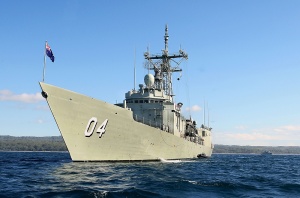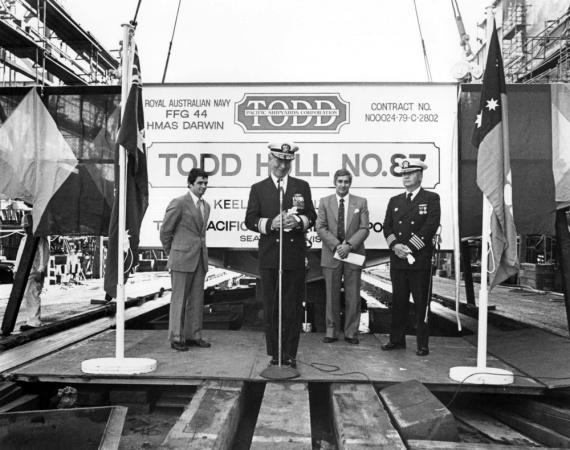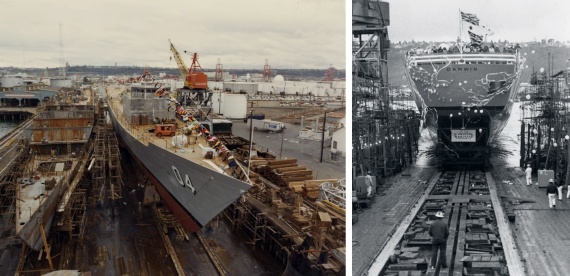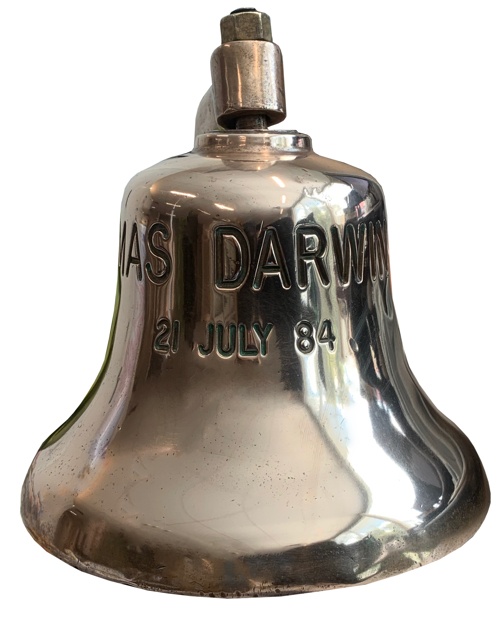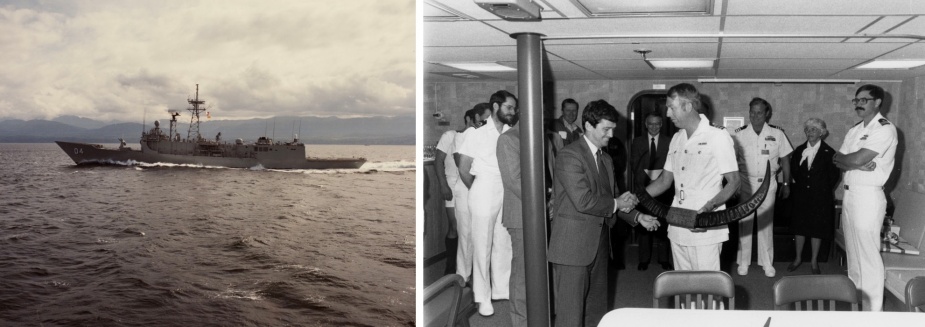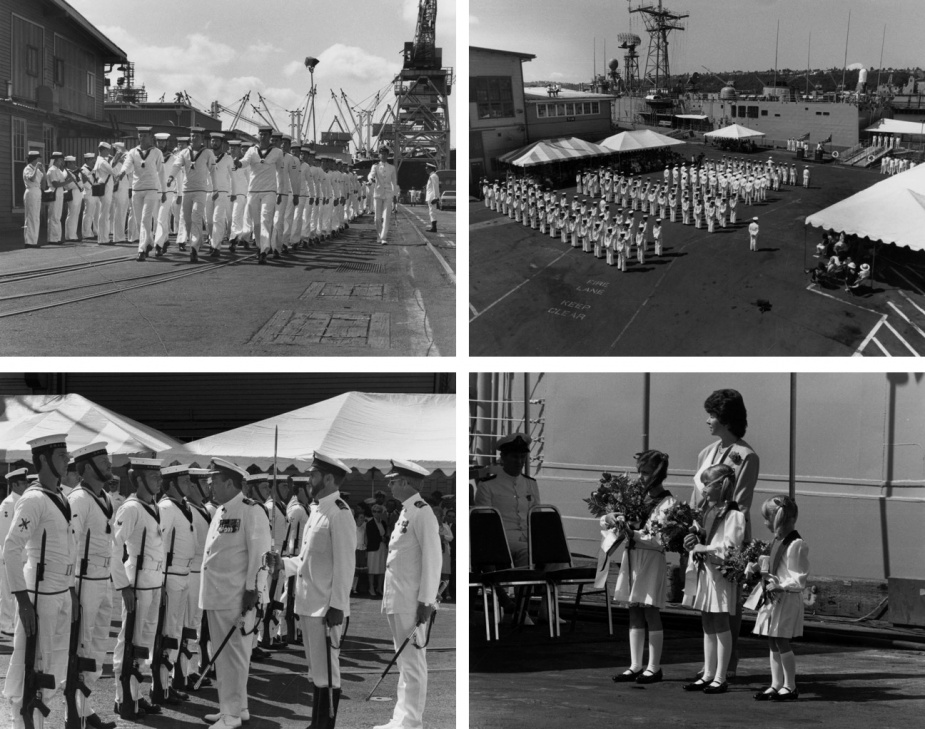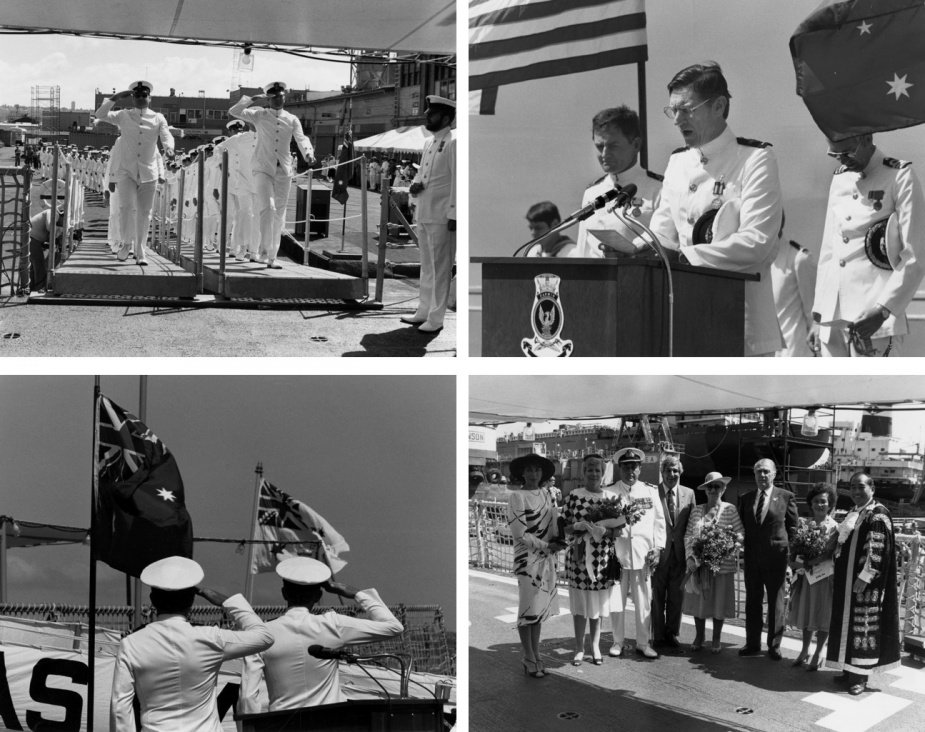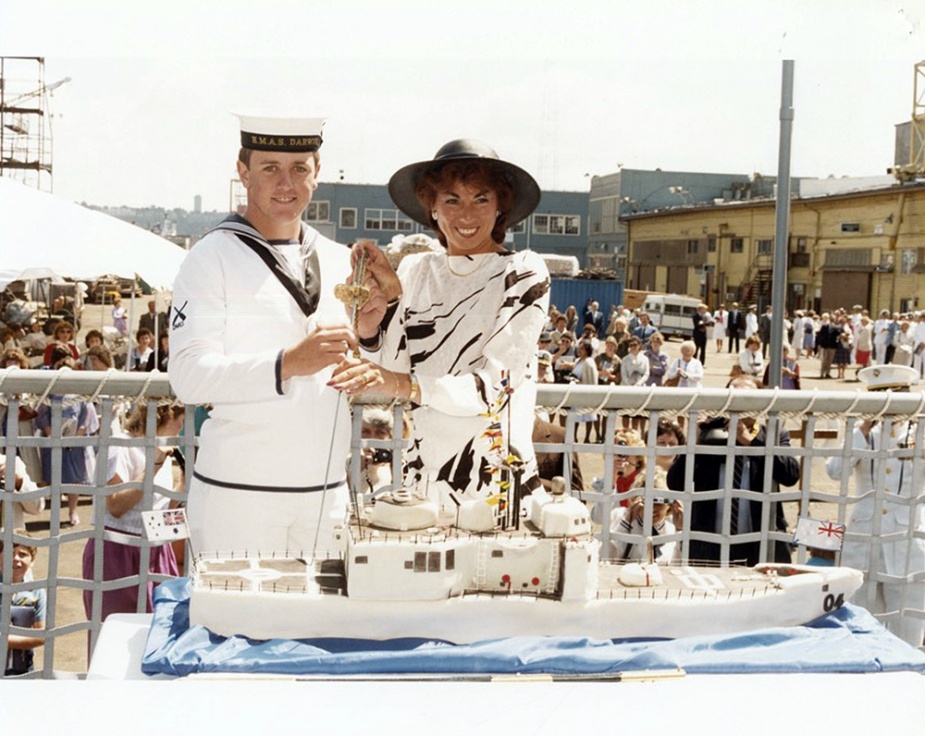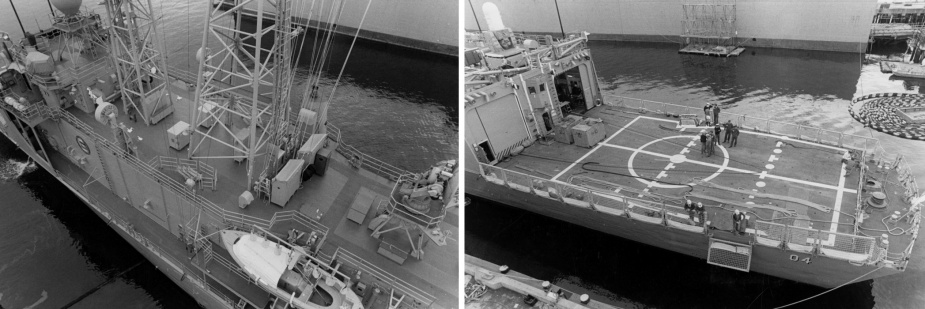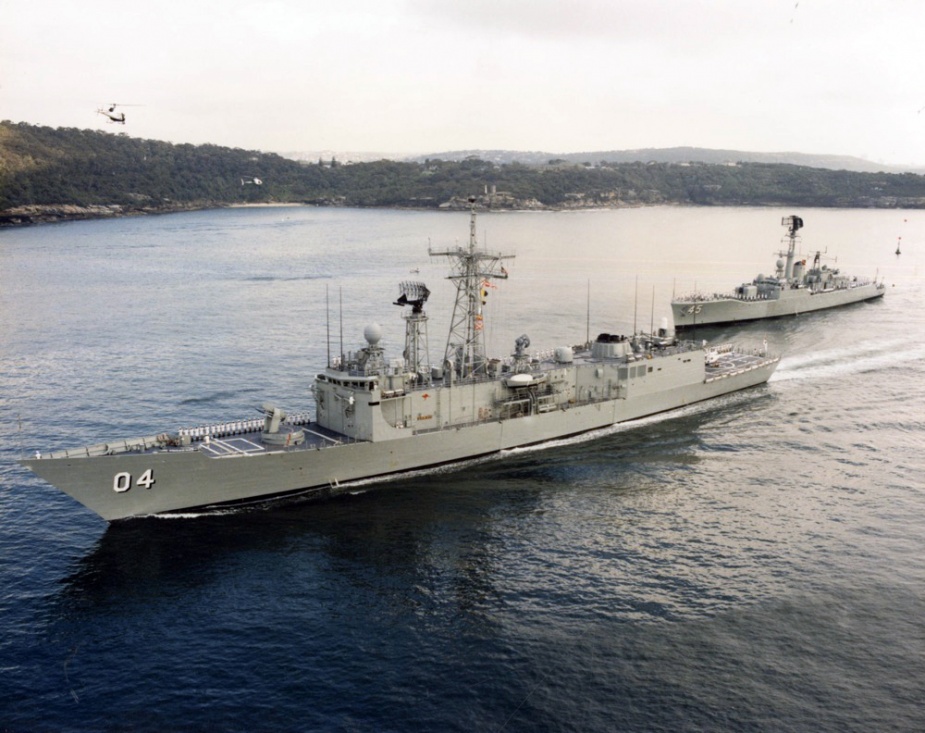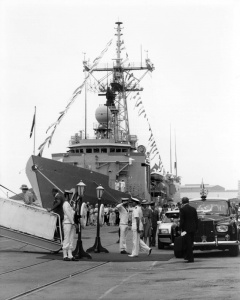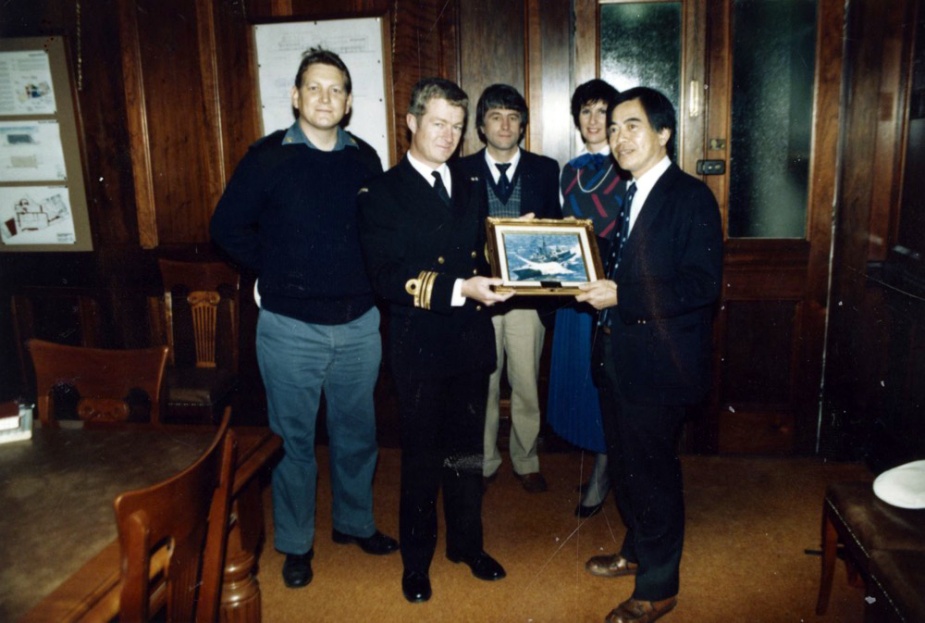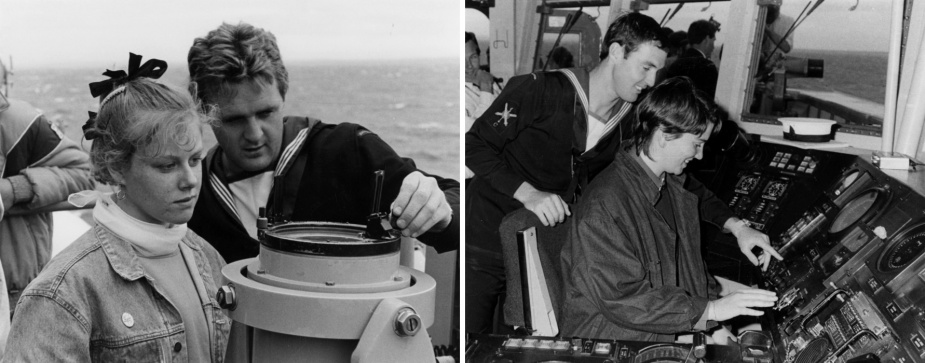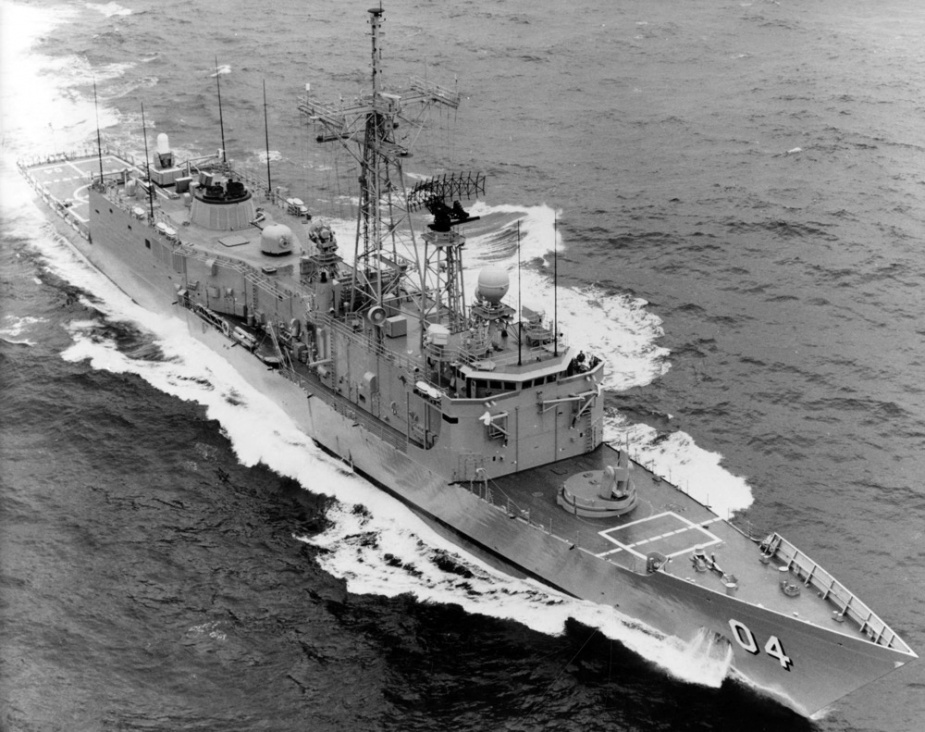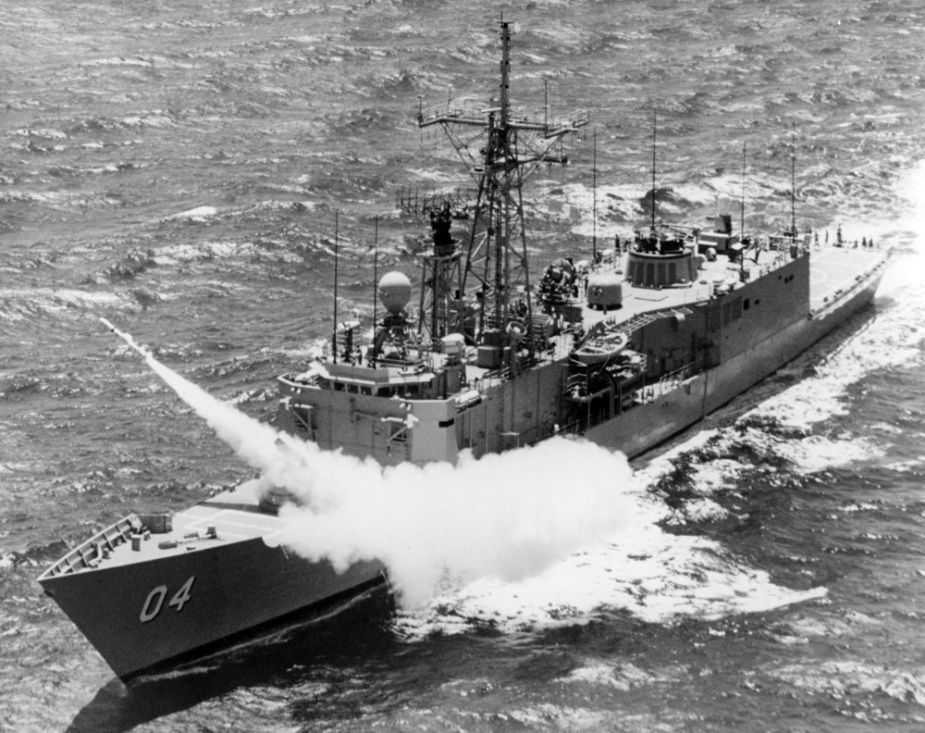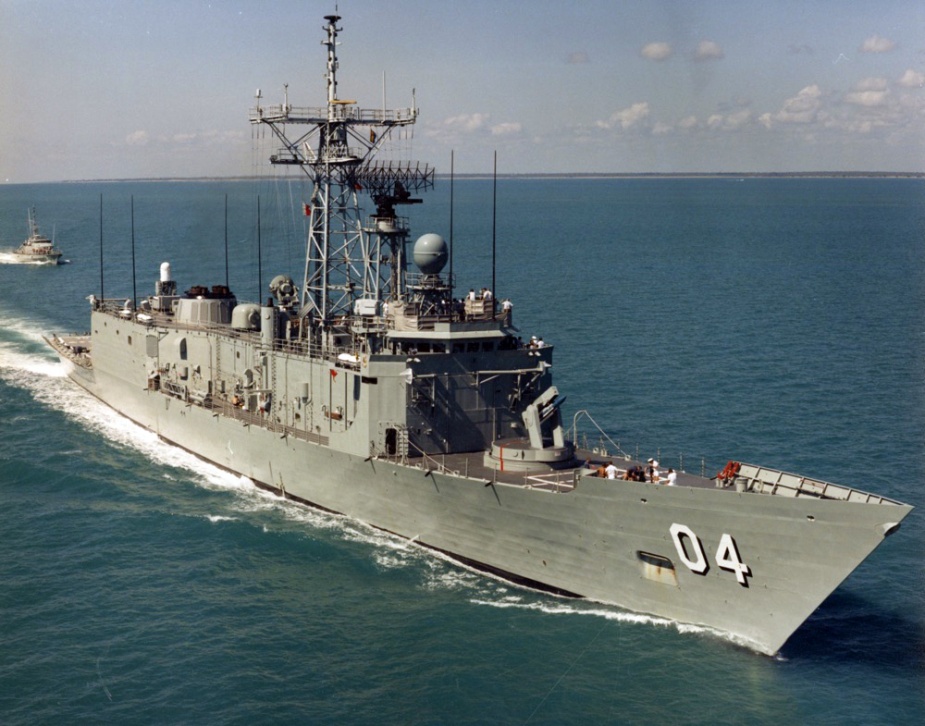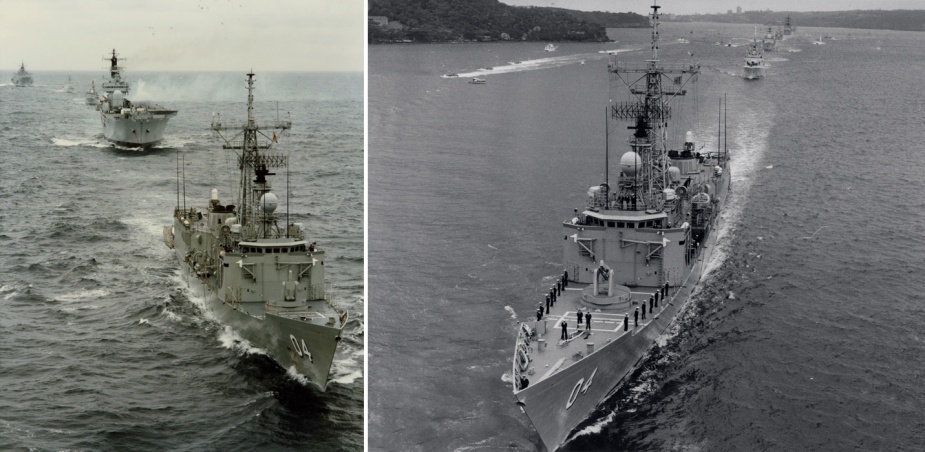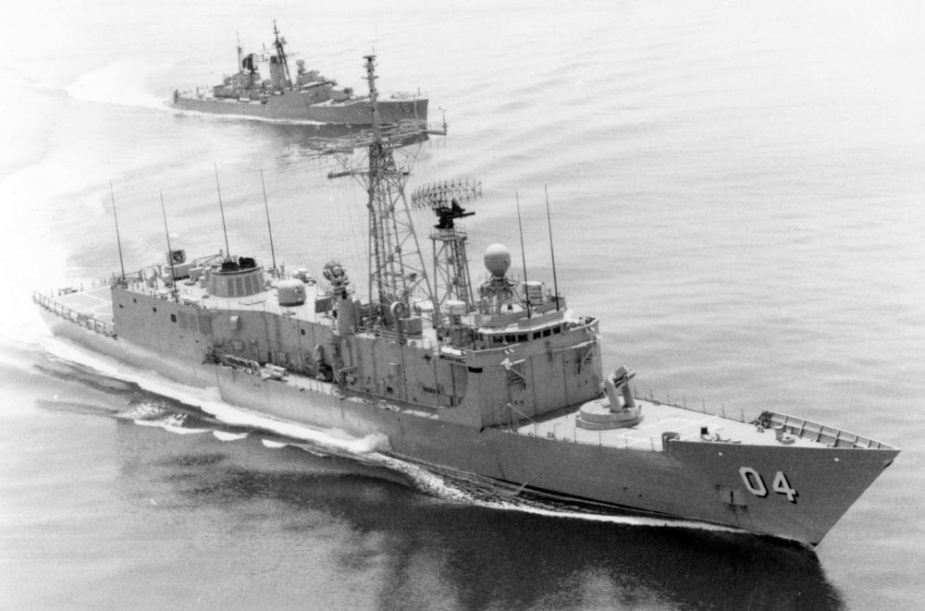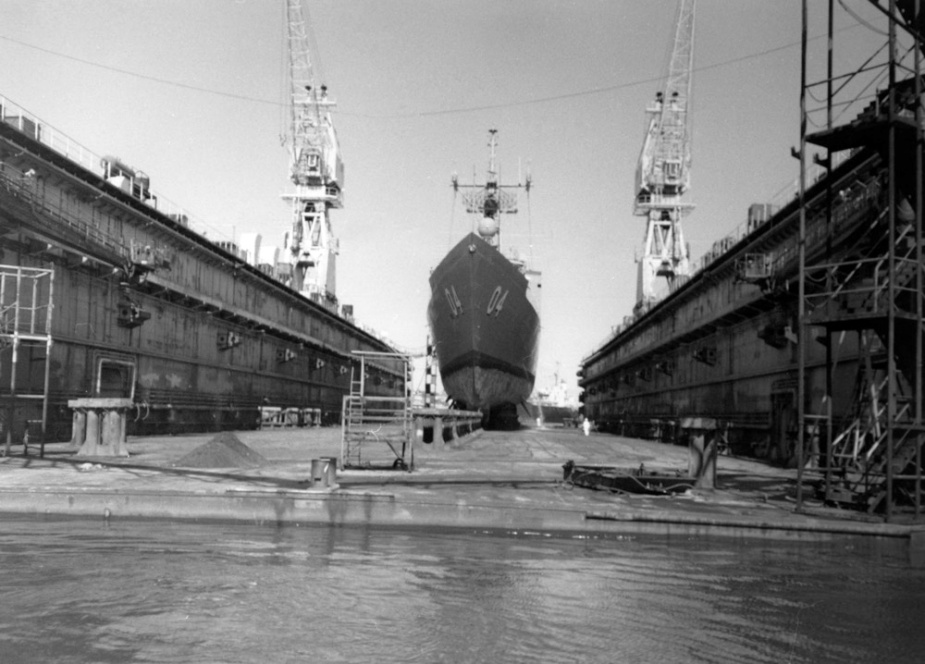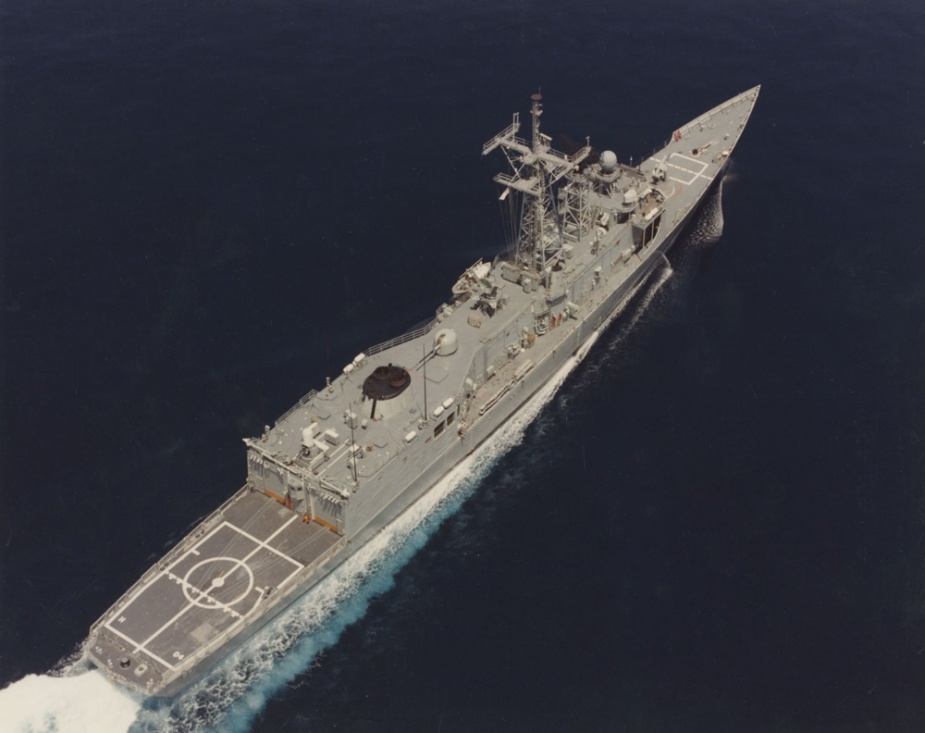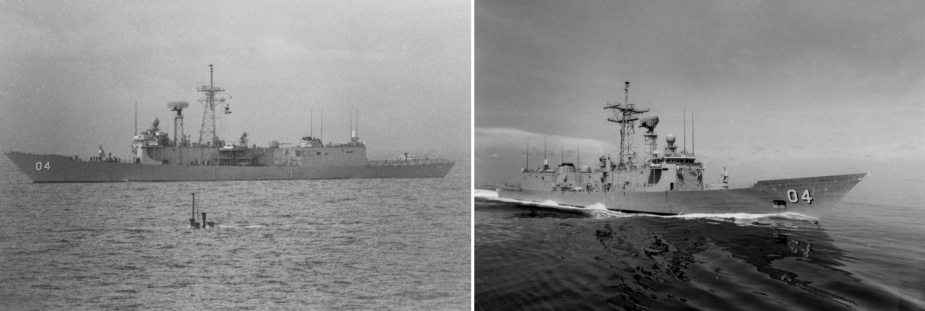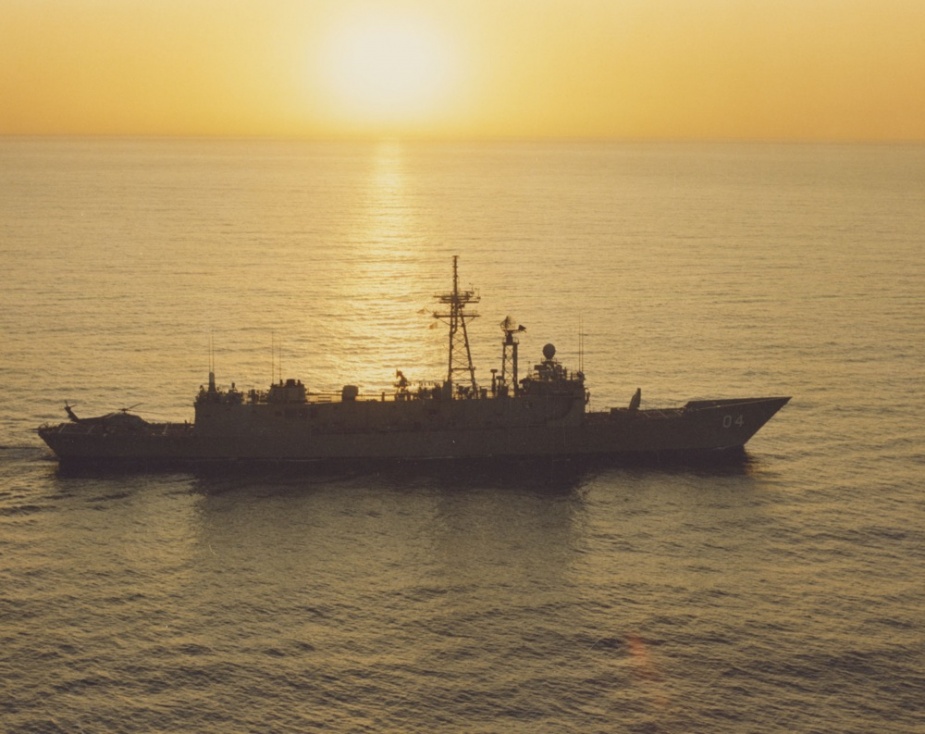HMAS Darwin
| Class |
Adelaide Class |
|---|---|
| Type |
Guided Missile Frigate (FFG) |
| Role |
|
| Pennant |
FFG 04 |
| International Callsign |
VKDA |
| Motto |
Resurgent |
| Builder |
Todd Pacific Shipyard Corporation, Seattle |
| Laid Down |
3 July 1981 |
| Launched |
26 March 1982 |
| Launched by |
Mrs Joan Johnston, CStJ |
| Commissioned |
21 July 1984 |
| Decommissioned |
9 December 2017 |
| Dimensions & Displacement | |
| Displacement | 4267 tonnes |
| Length | 138.1 metres |
| Beam | 13.7 metres |
| Draught | 4.5 metres |
| Performance | |
| Speed | 29 knots |
| Range | 4500 nautical miles |
| Complement | |
| Crew |
|
| Propulsion | |
| Machinery |
|
| Armament | |
| Missiles |
|
| Guns |
|
| Torpedoes | 6 x Mk 32 (2 triple) tubes |
| Physical Countermeasures |
|
| Electronic Countermeasures |
|
| Radars |
|
| Sonars |
|
| Combat Data Systems | ADACS. OE-2 SATCOM; Link 11. Link 16. |
| Weapon Control Systems |
|
| Helicopters |
|
| Awards | |
| Battle Honours | |
| Resources | |
| Image Gallery | |
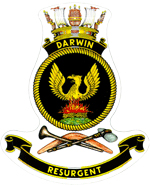
HMAS Darwin was the fourth of six Adelaide Class guided missile frigates (FFG) to serve in the Royal Australian Navy (RAN). She was built at the Todd Pacific Shipyards in Seattle, Washington, USA, and was launched on 26 March 1982 by Mrs Joan Johnston, the wife of Commodore Eric Johnston, AO, AM, OBE, RAN, the Administrator of the Northern Territory. The first four FFGs, HMA Ships Adelaide (II), Canberra (II), Sydney (IV) and Darwin, were built in the USA with subsequent modifications undertaken in Australia. The last two, HMA Ships Melbourne (III) and Newcastle, were constructed in Australia with all modifications incorporated.
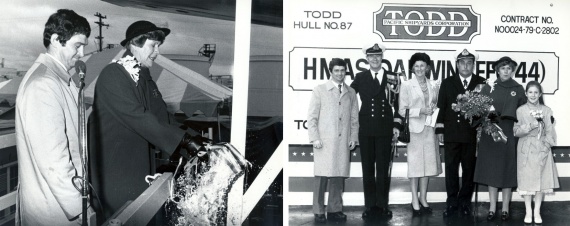
The Adelaide Class was based upon the US-designed Oliver Hazard Perry Class FFG. The concept for this class originated in 1971 when the United States Navy (USN) initiated a programme to build 50 patrol frigates. These were later redesignated guided missile frigates designed for long-range escort with roles including air defence, anti-submarine warfare, surveillance, interdiction and reconnaissance. They were capable of countering simultaneous threats from the air, surface and sub-surface. These ships were the first RAN ships to be powered by gas turbines as their main propulsion and could be underway in less than 30 minutes. Two forward mounted retractable auxiliary propulsion units provided a secondary means of propulsion plus excellent manoeuvrability in confined waters.
The decision to purchase the FFGs from the USA, and the consequent training programme required of their crews, led to the establishment of the RAN FFG Ashore Support Office to provide administrative support to the ships' personnel and their dependents. The FFG Ashore Support Office began operations at the US Naval Station, Long Beach, California, on 1 February 1980 and moved to Bellevue, Washington, on 15 September 1982. The office performed a range of support tasks including salary and allowance payments, travel and accommodation arrangements, removals assistance and other personal services.
The commissioning crews also received training and other practical support from the USN's Fleet Introduction Team in Seattle. The team was embedded as a 'nucleus crew' for FFGs under construction at the Todd Pacific Shipyards and integrated with the commissioning crew to provide training and ensure continuity through the construction and trials process.
Darwin commissioned in Seattle on 21 July 1984 under the command of Commander Rick Bayley, RAN. The day after her commissioning, eight crew members' children, three of whom had been born in the USA, were christened on board by Principal Chaplain, the Venerable Archdeacon John Jones, RAN.
The USN's Pacific Fleet Mobile Training Team embarked on 23 July and remained on board for the following week to assist with training and preparations for the ship and crew's impending trials and evaluations, while the embarkation of stores and equipment continued for the rest of the month. The Pacific Fleet Mobile Training Team embarked twice more during August during a flurry of activity in preparing the ship for sea. Darwin moved from the Todd Pacific Shipyards to the United States Coast Guard Support Centre (USCGSC), using auxiliary propulsion and tugs, on 14 August where she underwent a series of examinations to test her readiness to proceed to sea. She cast off and proceeded to sea for the first time on 31 August to conduct shakedown exercises in Puget Sound before returning to her USCGSC berth that evening.
With the majority of contractor trials and certifications completed, the transition from Darwin being a ship under construction to an operational unit of the RAN began in earnest in September 1984. After months of harbour training, the ship and her crew spent most of the month operating in the Puget Sound area and the Juan de Fuca Strait conducting various sea trials and exercises. She crossed the border on 15 September to conduct her first port visit to Esquimalt, Canada.
On 9 October 1984 Darwin departed Seattle for San Diego, California, where she continued trials and exercises in company with other USN and USCG units. The trials were overseen by the USN Fleet Training Group (FTG). The excellent relationship between the RAN and USN was illustrated when the FTG went to some effort to secure the availability of two Sikorsky Seahawk helicopters for training serials following the Australian Government's decision earlier in the month to acquire Seahawks for the RAN. She departed San Diego for the Long Beach Naval Station in Los Angeles at the end of the month. Trials and exercises continued throughout November and into December, though some exercises were cancelled at the beginning of December due to the presence of a Soviet potential intelligence collection (PIC) vessel. Further exercises were punctuated by visits to San Francisco, Port Hueneme and Sacramento, where Darwin became the first Australian warship to visit the Californian capital. Darwin then returned to Seattle for Christmas and New Year.
1985
Final Contractor Trials began in January 1985, followed by Post Shakedown Availability in February. Darwin then put to sea from 18 to 20 June for a brief series of trials before the Post Shakedown Availability was formally completed on the 28th. She commenced a week of shakedown exercises on 1 July before proceeding once again to San Diego for a further series of exercises, trials and certifications in the Californian exercise areas. Darwin rendezvoused with another RAN unit for the first time when she escorted the submarine, HMAS Onslow, into San Diego on 17 July.
Exercises in company with Onslow and USS Berkeley were suspended on 31 July when Darwin and Berkeley observed two red flares. It was thought at first that Onslow was in difficulties and surfacing procedures were initiated; however, Onslow surfaced and verified her safety. Search procedures continued given the validity of the flare sightings and the three vessels were shortly joined by USS Meyerkord and aircraft from the carrier, USS Enterprise. The search could find no explanation for the flares, however, and it was discontinued early the following morning.
Darwin returned to Seattle on 11 August and officially came under the operational control of the Commander Australian Fleet on the 27th. She departed Seattle that morning and set course for Vancouver, Canada, where she joined activities celebrating the Royal Canadian Navy's (RCN) 75th Anniversary along with Onslow and HMAS Hobart (II). On 30 August she anchored in Royal Roads off Esquimalt, along with 18 other ships from Australia, Canada, New Zealand and the USA, where she participated in the Naval Review the following day. Anniversary events continued throughout the following week with Darwin alongside in Esquimalt for the majority of that time.
With the RCN Anniversary events completed, Darwin participated in her first fleet exercise, Exercise MARCOT, along with Onslow, Hobart and other USN and RCN units in September. Upon the conclusion of MARCOT, Darwin visited Victoria, Canada, and made her final visit to Seattle at the end of the month. She departed Seattle, in company with Hobart, for passage to Australia on 27 September and arrived at Darwin, via Pearl Harbor and Suva, on 25 October. Upon her approach to Darwin she also embarked the ship's AS 350B Squirrel flight for First of Class Flying Trials. A large armada of private boats and yachts, as well as a flypast of four Mirage aircraft from 75 Squadron RAAF, welcomed Darwin to her namesake port for the first time. The following day Darwin was granted Freedom of Entry to her namesake city which was exercised with a march through the city streets to the Darwin City Centre.
She departed Darwin on 30 October arriving in her home port of Sydney, via Cairns, on 8 November where she commenced a leave and maintenance period.
1986
Darwin returned to sea on 2 January 1986 to commence shakedown and work-up exercises in the Jervis Bay area. During the exercises cracks were detected in the ship's superstructure which necessitated repair work being undertaken at Garden Island Dockyard.
On the morning of 24 January, Darwin joined HMA Ships Hobart (II), Sydney (IV), Parramatta (III), Derwent, Vampire (II) and Onslow for a formation entry into Sydney Harbour, the first event marking the 75th Anniversary of the granting of Royal Assent to the RAN. The Governor-General, His Excellency Sir Ninian Stephen, AK, GCMG, GCVO, KBE, and the Chief of Naval Staff, Vice Admiral Michael Hudson, AO, RAN, accepted the salute aboard HMAS Geelong (II), anchored off Bennelong Point. Darwin berthed at East Dock Wall before a detachment of the ship's company took part in a 1200 strong march through the city streets, exercising the RAN's right of Freedom of Entry to Sydney.
Darwin remained alongside conducting maintenance and command team training until 3 February when she put to sea to participate in a Fleet Concentration Period (FCP) which included passage south to Hobart in company with HMA Ships Stalwart (II), Hobart (II), Perth (II) and Canberra (II) to take part in the Royal Hobart Regatta as well as other 75th Anniversary events. Exercise TASMAN SEA commenced at the end of the month and continued until 6 March when Darwin berthed at Station Pier Outer West in Melbourne. That afternoon the royal yacht, HMY Britannia, berthed astern of Darwin and the frigate chopped to the command of Flag Officer Royal Yacht, beginning her duty as Royal Escort. Her Majesty the Queen and His Royal Highness the Duke of Edinburgh embarked in Britannia that evening before the two ships sailed out of Port Phillip Bay.
The Royal Yacht and her consort anchored off Westernport the following morning where Darwin fired a 21 gun salute as Her Majesty and His Royal Highness disembarked to present a new Establishment Queens Colour to the RAN at HMAS Cerberus. The royal party re-embarked that afternoon before the ships continued their voyage to Adelaide where they arrived on 9 March. The visit to Adelaide included celebrations for the city's 150th anniversary and coincided with the birthday of His Royal Highness Prince Edward, Earl of Wessex, which was also marked with a 21-gun salute. His Royal Highness the Duke of Edinburgh inspected Darwin on 11 March and the following day a small detachment of the ship's company enjoyed an audience with Her Majesty the Queen aboard Britannia. Her Majesty later presented Darwin's Commanding Officer, Captain Hector Donohue, RAN, with a signed photograph to mark the occasion. The Royal Squadron disbanded on 13 March after Her Majesty and His Royal Highness departed by air for the UK. Darwin received the following message after the departure of the Royal Party:
Thank you for your escort during my visits to Victoria and South Australia. I have been much impressed by the admirable way in which you have carried out your duties and the smart appearance of your ship and her company. Prince Philip and I greatly enjoyed your splendid steam-past on Sunday, and he has spoken highly of what he saw during his visit to you. I also understand that Darwin acquitted herself very well during yesterday's sea day demonstration. Please convey the best wishes of Prince Philip and myself to all on board, and our hope that you enjoy a well-deserved leave period in Sydney.
Splice the mainbrace.
Elizabeth R
Darwin departed Adelaide on 17 March arriving back home in Sydney three days later.
Darwin and her sister ship, Sydney, departed Sydney on 30 April for a Pacific Ocean deployment, which included transporting medical stores to Suva, Fiji. Thereafter they conducted exercises with the USS Carl Vinson Battle Group on 14 May before arriving in Hawaii on 16 May to participate in the major multi-national USN-led RIMPAC 86 Exercise along with more than 50 other ships, 250 aircraft and 50,000 sailors, airmen and marines. At one stage Darwin embarked a US Navy SEAL team for simulated clandestine operation exercises. The two frigates departed Pearl Harbor on 25 June following a successful Exercise RIMPAC. Darwin arrived back in Sydney, via Suva and Auckland, on 18 July.
In early August a number of Darwin's ship's company undertook volunteer work at one of the ship's chosen charities, the Camperdown Children's Hospital. There they busied themselves on what was to become the hospital's new parents' hostel before rejoining their ship and resuming the normal pattern of exercises, training and maintenance.
Participation in the second Fleet Concentration Period of the year followed in September and, on 20 September, a contingent from the ship's company took part in a march through the streets of Brisbane as part of the RAN's 75th Anniversary celebrations. On 29 September, Darwin was one of 40 ships from seven nations which entered Sydney Harbour in formation for the RAN 75th Anniversary Naval review. A contingent of the ship's company again participated in a march, this time through the streets of Sydney, on 2 October. The frigate then came to anchor off Fort Denison on 4 October, with various VIPs embarked, to witness the review by His Royal Highness, Prince Philip, the Duke of Edinburgh, embarked in HMAS Cook.
Upon completion of her Naval Review responsibilities, Darwin departed Sydney on 7 October for Melbourne to participate in the multi-national Exercise CROWEATER. The exercise concluded on 21 October and the next day Darwin arrived at Wallaroo, South Australia, where she enjoyed a four-day visit before returning to Sydney on 28 October. She returned to sea early in December for a brief but busy period of exercises, trials, inspections and ceremonial activities before commencing Christmas leave and entering refit in the New Year.
1987
Darwin returned to sea in the evening of 15 May 1987 to commence post-refit trials and exercises. She visited Brisbane for the Queen's Birthday weekend in June, and Newcastle in July.
On 3 August as she proceeded to a rendezvous with HMAS Otama south east of Sydney, the submarine reporting that she had lost two submariners overboard; Able Seaman Hugh Marcrow and Seaman Damian Humphreys. A search was initiated with Darwin assuming the responsibilities of on-scene commander (OSC). In what was later described as atrocious weather and sea conditions, the search was bolsted by HMA Ships Fremantle (II), Ipswich (II), Geelong (II), Dubbo (II), Adelaide (II) and Parramatta (III), RAN and RAAF aircraft, four NSW Police launches, the merchant vessel MV Conus, and five civilian helicopters. The search continued until 6 August but the bodies of the two submariners could not be found. Darwin departed the scene early that morning handing over OSC responsibilities to Ipswich. A large number of the ship's company attended a memorial service for Able Seaman Hugh Marcrow and Seaman Damian Humphreys at the Garden Island Naval Chapel the following day.
Darwin departed Sydney on 13 August for a two-month circumnavigation of Australia, initially proceeding north into Queensland waters. Her deployment took her first to Cairns and then Darwin where the ship's company exercised the right to Freedom of Entry to the city and conducted fund raising activities for another of the ship's charities, the Northern Territory Association for the Blind and Visually Impaired. The visit to Darwin was marred, however, by the tragic death of Able Seaman DG Walden in a car accident near Hays Creek. Two other Darwin sailors were also injured in the crash. The ship departed her namesake city on 25 August and a memorial service for Able Seaman Walden was conducted on board that evening.
Darwin participated in Fleet Concentration Period 87-2, which began in Western Australian waters on 31 August and also involved the USS Constellation Battle Group; and, following her first visit to HMAS Stirling, she also took part in Exercise VALIANT USHER in September. She returned to Sydney, via Fremantle and Melbourne, on 9 October before participating in the joint air defence Exercise TASMAN RULER in conjunction with other RAN, RAAF and Royal New Zealand Air Force (RNZAF) units.
She visited Melbourne and Hobart in November, and in December escorted an international fleet of ‘tall ships’ in Australian waters for the impending Bicentennial celebrations, into Port Philip Bay. Darwin was awarded the Otranto Shield and Voyager Trophy for excellence in gunnery and anti-submarine warfare respectively in 1987.
1988
Much of the first half of January 1988 was spent preparing for Australia's Bicentennial celebrations and on the 18th, the ship embarked Flag Officer Naval Support Command, Rear Admiral David Martin, AO, RAN, Mrs Martin and some 40 members of the media to witness the First Fleet re-enactment entry to Botany Bay.
On the morning of 22 January, Darwin joined 13 other RAN vessels and entered Sydney Harbour in formation for the RAN Bicentennial Salute to Australia. The formation passed the Governor-General, His Excellency the Right Honourable Sir Ninian Stephen, AK, GCMG, GCVO, KBE, embarked in HMAS Fremantle (II) at Bennelong Point. Stalwart fired a 21 gun salute while Darwin paraded a royal guard and saluted His Excellency. In the afternoon of Australia Day, Darwin embarked some 200 VIP guests and 40 members of the media to witness the Tall Ships Parade of Sail. Anchored off Bradleys Head nearby HMAS Cook with Their Excellencies, the Governor-General and Lady Stephen, and Their Royal Highnesses, the Prince and Princess of Wales embarked, they watched as some 169 tall ships sailed past the reviewing area and out to sea. That evening, with the VIPs disembarked, many family and friends of the ship's company came aboard to watch the Australia Day fireworks.
A busy period of exercises followed the Bicentennial celebrations with Darwin taking part in a Fleet Concentration Period and Exercise TASMAN RULER in February; followed by the international Exercise FLYING FISH in March which culminated in a visit to Melbourne and a detachment of the ship's company participating in a march through the city exercising the RAN's Right of Freedom of Entry ahead of the Moomba Festival.
Following a leave and maintenance period, Darwin departed Sydney on 6 May bound for Hawaii and participation in Exercise RIMPAC 88. She visited; Cairns; Gove; Darwin where a donation was made to the Northern Territory Association for the Blind and Visually Impaired following a fund-raising drive on board; Port Moresby; Pago Pago; and Swains Island where stores including medical supplies were landed for the island's entire population of 32. A visit to Port Vila was cancelled due to political unrest and rioting in the Vanuatu capital. She arrived at Pearl Harbor on 16 June having rendezvoused with HMA Ships Hobart (II), Success (II), Canberra (II) and Parramatta (III) en route.
RIMPAC exercises began on 24 June involving some 45 ships, 200 aircraft and 50,000 personnel, and continued until 19 July. The following week, Darwin departed Pearl Harbor for home in company with Hobart, Canberra and Parramatta. She detached from the task group on 30 June arriving back in Sydney on 15 August via; Tarawa; Banaba Island where she delivered stores and medical supplies; Honiara where crew members conducted maintenance work at local schools; and Gladstone. She also conducted a fisheries patrol around the Kiribati Islands at the request of the Kiribati Government. Upon her arrival back in Sydney she commenced a leave and maintenance period.
Darwin returned to sea on 23 September and two days later she joined the international armada assembling for the Bicentennial Naval Salute. She joined 30 other ships for a formation entry into Sydney Harbour on the 26th and a detachment of the ship's company participated in a march through the streets of Sydney on the 29th. On 1 October she took part in the International Fleet Review which featured some 60 ships from 15 international navies. The opportunity was taken to conduct multi-national exercises upon the conclusion of Bicentennial celebrations. 18 vessels from six foreign navies joined 11 RAN vessels for exercises off the New South Wales coast before the fleet disbanded and Darwin went on to visit Brisbane later in the month.
On 1 November a civilian Piper Navajo aircraft, performing a target-towing service under contract to the RAN, crashed into the sea south east of Sydney while operating with HMAS Success (II). Success initiated an immediate search and was shortly joined by Darwin which assumed the role of on scene commander. HMA Ships Canberra (II) and Parramatta (III), and HNLM Ships Jan Van Brakel and Kortenaer also joined the search along with numerous naval and civilian aircraft but, tragically, no trace of the aircraft or its three person crew could be found. The search was curtailed the following afternoon.
The year closed with a port visit to Newcastle in November before entering a well-earned leave and maintenance period in Sydney early in December.
1989
Darwin returned to sea on 23 January 1989 for shakedown and workup exercises, taking part in Fleet Concentration Period 89-1 and Exercise TASMAN RULER in February.
Darwin departed Sydney for South East Asian waters on 3 April; however, a propeller strike and consequent grounding on a reef off Hayman Island forced her to return to Newcastle to effect repairs. With repairs complete she departed Newcastle on 19 April and resumed her deployment via Cairns and Darwin. Shortly after arriving in Asian waters she rendezvoused with Parramatta and the pair remained in company for most of the deployment. Darwin visited Sattahip, Kuantan, Kota Kinabalu, Manila, Subic Bay, Hong Kong, Singapore and Jakarta, and conducted passage exercises with Thai, Malaysian, Philippine, US, British and Singaporean defence forces. She participated in the multi-national Exercise STARFISH, and Exercise AUSINA alongside Australian and Indonesian units in July.
Upon her return to Australian waters, Darwin led a fleet of 16 RAN and two USN vessels into Darwin Harbour on 28 July for Exercise KANGAROO 89. The following day RAN and USN sailors combined for a march through the City of Darwin before KANGAROO commenced in earnest on 1 August. Darwin cast off that morning with the Chief of Naval Staff, Vice Admiral Mike Hudson, AC, RAN embarked to observe the initial exercises.
Darwin's participation in the exercises was interrupted when she received a mayday call from a Sea King helicopter operating nearby on 6 August. The aircraft was recovered without incident and returned to Darwin. The ship remained alongside while the defect in the helicopter was rectified and re-joined the exercises on the 8th. The 9th was a 'shop window' day with a number of VIPs observing exercises at sea. Embarked in Darwin at various times during the day were; the Prime Minister, the Honourable Mr Bob Hawke, AC, MP; the Minister for Defence, the Honourable Mr Kim Beazley, MP; the Chief of the Defence Force, General Peter Gration, AC; and Vice Admiral Hudson.
KANGAROO concluded on 20 August and Darwin immediately proceeded to Sydney, via Cairns, where she arrived on 1 September. Eleven members of the ship's company received commendations for their performance over the course of the five month deployment.
Darwin returned to sea on 11 September taking part in a series of trials in conjunction with the Defence Science and Technology Organisation (DSTO). The following week she crossed the Tasman for a goodwill visit to New Zealand's South Island. From there she visited Melbourne early in October before returning to Sydney on 11 October, where she resumed the normal pattern of weekly running in the East Australian Exercise Area (EAXA).
First of class flying trials for the S70B-2 Seahawk helicopter began in November and continued into December. During that time the frigate again visited Melbourne in December before entering an extended maintenance period to see out the 1980s. The year ended on a good note when Darwin's Action Information Organisation (AIO) was presented with the AIO Shield for 1989.

